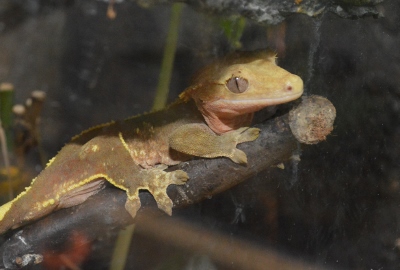
It’s February 29th, also known as Leap Day, and the crested gecko is leaping away as our Animal Of The Month for February. If you’ve been following us on Twitter @ExoticPetVets, you will have seen our tweets about crested geckos being very good at jumping, so is it any wonder they’re leaping away on Leap Day? We also tweeted so many other fun facts about crested geckos throughout the month and we hope you enjoyed them. If you missed any of our tweets, here is a summary. Did you know?:
- Crested geckos are native to New Caledonia, which is an archipelago between Fiji and Australia.
- Crested geckos were once classified as Rhacodactylus ciliatus, but were reclassified as Correlophus ciliatus in 2012.
- Genetic research showed crested geckos weren’t as closely related to other geckos in the Rhacodactylus genus as believed.
- The ciliatus part of the crested gecko’s scientific name means “eyelash” in Latin.
- Crested geckos have projections of skin over the top part of their eyes which look like large eyelashes.
- Crested geckos are sometimes referred to as “eyelash geckos,” while many reptile enthusiasts call them “cresties.”
- Crested geckos were believed to be extinct until 1994 when they were found again in the wild.
- The IUCN lists crested geckos as a vulnerable species in the wild mainly because of habitat loss.
- In captivity, crested geckos are bred in large numbers for the pet industry.
- They don’t have eyelids so crested geckos can’t close their eyes.
- Crested geckos have a transparent scale called a spectacle over each eye to help protect their eyes and keep them moist.
- To keep their eyes clean, crested geckos lick their eyeballs.
- Crested geckos have sticky plate-like toes called lamellae, which let them climb smooth surfaces like glass.
- Crested geckos love to climb and are arboreal, meaning they live in trees in the wild.
- In captivity, crested geckos should have plants and wood available to them for places to climb and rest.
- If they feel threatened, crested geckos will lose their tails. It’s common for adults in the wild to not have tails.
- Losing their tails is a mechanism that helps crested geckos flee from predators.
- When dropped, a crested gecko tail will move independently for a couple of minutes, which can confuse a predator.
- Unlike some other reptiles, crested geckos do not regrow their tails. Once their tails are gone, they’re left with a nub.
- Like all other reptiles, crested geckos will shed their skin regularly.
- Crested geckos will peel their own shedding skin off by licking, chewing and rubbing it off their bodies.
- Crested geckos will eat their entire shed for nutrients. It also helps hide evidence of their presence from predators.
- Crested geckos are pretty good at jumping and they will often jump when they’re stressed.
- When handling crested geckos, ensure they won’t have far to fall if they leap off you (e.g. don’t put them on your head)
- It’s best to handle crested geckos while sitting and around soft surfaces in case they do leap away suddenly.

